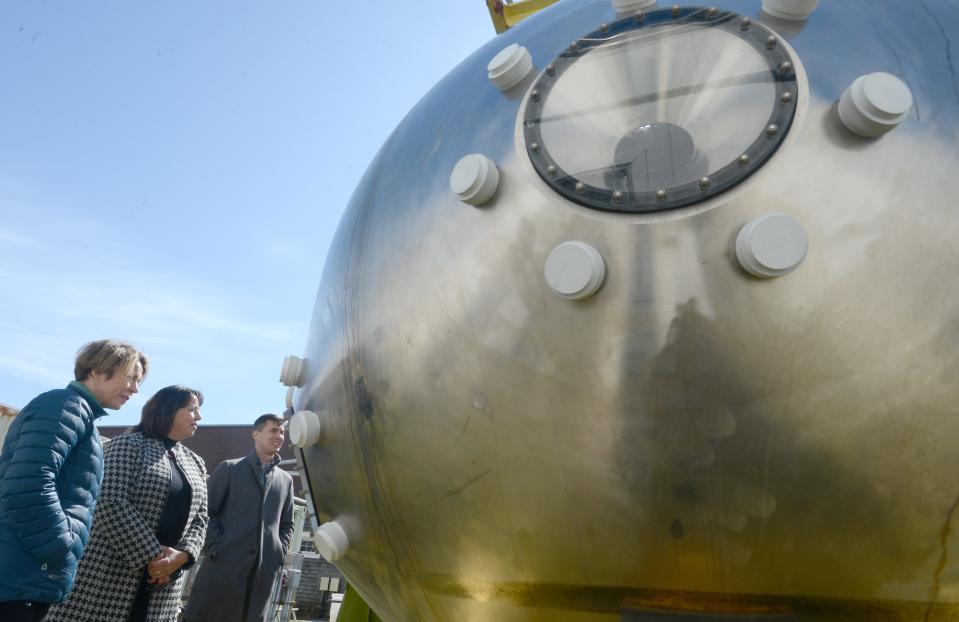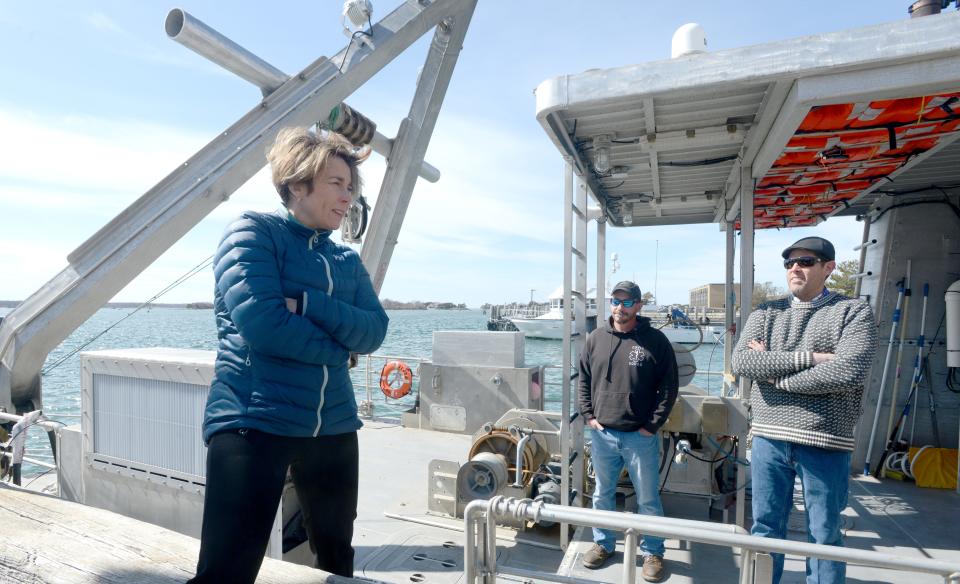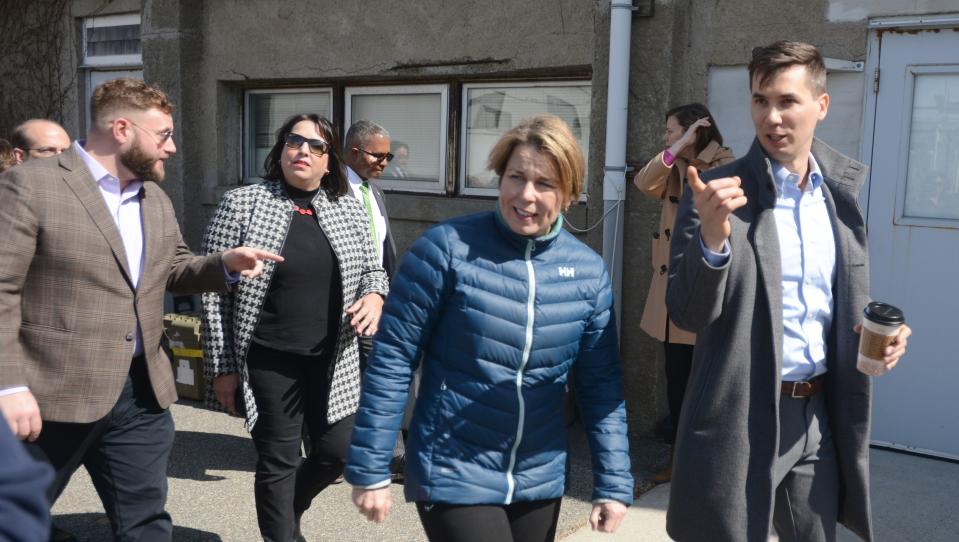Healey praised for focus on climate, blue economy at visit to Cape Cod science hub
- Oops!Something went wrong.Please try again later.
- Oops!Something went wrong.Please try again later.
WOODS HOLE — Under a blue sky teeming with squawking seagulls, as a clean breeze snapped the flags flying over Research Vessel Tioga, Gov. Maura Healey and Lt. Gov. Kim Driscoll on Thursday toured the Woods Hole Oceanographic Institution pier at the Iselin Marine Facility.
The visit was to hear about the work scientists are undertaking to meet the challenges of climate change, their research into the marine ecosystem, and their work to develop and put to use new technologies for monitoring the oceans, as well as to highlight the administration's commitment to supporting coastal resiliency solutions, green energy, and a blue economy.
"My administration is committed to going all in on climate, and in our recent budget proposal we've proposed historic investments in efforts to address our changing climate," Healey said. "That includes significant funding for coastal resiliency efforts for building up the infrastructure that we need."

She noted she has also established a climate chief posting — the first of its kind, she said — "who's overseeing all of this work in driving a climate economy."
"I've said we have the opportunity to make historic investments in marine science and fisheries, as well as in industries that are going to power us away from fossil fuels," Healey said. "I think the work that's going on here at Woods Hole is really incredible. It really is not just a national force and leader. It's a global leader when it comes to some of these areas that I really want to invest in as governor."
Healey-Driscoll administration budget dedicates 1% of state's overall operating budget for fiscal 2024 to energy, environment office.
The Healey-Driscoll administration recently filed its fiscal 2024 budget recommendation, a $55.5 billion plan that, among other things, makes significant investments in climate action, according to the governor's office.
The budget dedicates 1% of the state’s overall operating budget to the Executive Office of Energy and Environmental Affairs. As part of that, the administration is looking to triple the budget of the Massachusetts Clean Energy Center to support local entrepreneurs, decarbonize buildings and "make the state the global capital of the clean energy economy," according to the governor's office.
During her Woods Hole visit, Healey noted Massachusetts has "an opportunity to really build out in a way no other state is positioned to do, a blue economy."

"We can create so many great jobs by investing in innovation, research, technology, (and) manufacturing," she said, "and really that can run all the way from Woods Hole here in Falmouth to North Adams in the Berkshires. That's what's possible if we drive this with intentionality and that's something that the lieutenant governor and I are committed to doing."
Healey and Driscoll were joined Thursday by Executive Office of Energy and Environmental Affairs Secretary Rebecca Tepper, state Sen. Julian Cyr, D-Truro, and state Sen. Susan Moran, D-Falmouth, state Rep. Dylan Fernandes, D-Woods Hole, and state Rep. David Vieira, R-Falmouth, Falmouth Acting Town Manager Peter Johnson-Staub, and members of the Falmouth Select Board.
An underwater device developed at Woods Hole Oceanographic Institution was used to find the remains of a shot-down balloon off the coast of South Carolina.
The tour included a stop in a lab where Carl Hartsfield, director and senior program manager of the oceanographic institution's Oceanographic Systems Lab, told them about scientists' work on remote environmental monitoring units, or REMUS vehicles, described by the institution as "low-cost autonomous underwater vehicles designed by the Oceanographic Systems Lab to operate with a simple laptop computer."
Focus on blue economy:Cape Cod Community Colleges hopes new STEM building will bring community together
"They do a whole host of things," Harstfield said, explaining they can explore 97% of the water column, meaning they are capable of the deepest dives into the ocean.
He noted the technology is some of the leading technology in the world and Woods Hole scientists are some of the only people in the world who can do it. The torpedo-like vehicles, according to the institution, were initially conceived for coastal monitoring, but are now also used as platforms "for a wide variety of instruments at a range of ocean depths." The U.S. Navy is among the entities that employs the vehicles — for example, Hartsfield said, a REMUS was used to find the remains of the suspected Chinese spy balloon that was recently shot down off the coast of South Carolina.
After hearing about the capabilities of the vehicles, and how they can go on a mission and autonomously return to a berth, Driscoll said they are like the "ultimate" household robot vacuum.
Healey and Driscoll show commitment to climate issues and blue economy, a Woods Hole Oceanographic Institution leader says.
Healey and Driscoll also stopped by the research vessel Tioga and met Capt. Peter Collins, and first mate James Missios, hearing about the work they are doing related to water quality management in Cape Cod Bay on behalf of the Massachusetts Water Resources Authority.
Another stop was to see the institution's submersible Alvin, which was used to survey the Titanic wreck. Peering through one of the small port holes in the titanium sphere, designed to transport a pilot and two scientists to crushing depths, Driscoll shook her head and pronounced, "never in a million years." The interior is about the same space as a telephone booth.
Never-before-seen footage of Titanic wreck site released to public: Watch live

Leading Thursday's tour was institution Deputy Director and Vice President for Science and Engineering Richard Murray, who said the the institution and its partners, NOAA Fisheries Science Center, Marine Biological Laboratory, the United State Geological Survey and SEA Education Association are thrilled with the Healey-Driscoll administration's commitment to climate issues and blue economy.
Murray called the leaders' support "refreshing and invigorating."
"The investments you are making," he told them, "are the proverbial rising tide that lifts all boats."
Gain access to premium Cape Cod Times content by subscribing.
This article originally appeared on Cape Cod Times: Proposed budget for fiscal 2024 prompts Healey visit to Woods Hole

